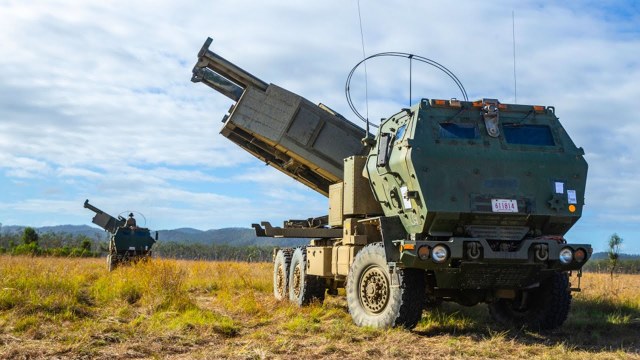On May 26, 2022, the US Department of Defense Agency for Military Cooperation (Defense Security Cooperation Agency - DSCA) sent a notification to the US Congress about the planned upcoming sale to Australia through the US program of intergovernmental foreign military sales Foreign Military Sales (FMS) at the request of the Australian government of HIMARS (High Mobility Artillery Rocket System) land-based missile systems manufactured by Lockheed Corporation Martin. This delivery is approved by the U.S. Department of State. The total cost of the proposed delivery will be $385 million, including missiles, and training and technical support packages.

M142 combat vehicles of the HIMARS missile system from the 3rd Division of the US Marine Corps in Australia during the joint US-Australian exercise Talisman Sabre 21, 07/23/2021 (c) USDS
According to the notification, Australia's supply should include 20 M142 HIMARS combat vehicles, 30 six-shot transport and launch modules with six GMLRS M30A2 correctable missiles in each, 30 six-shot transport and launch modules with six GMLRS M30A1 Alternative Warhead correctable missiles with a dissipated warhead in each, 30 six-shot transport and launch modules with six correctable missiles GMLRS M31A2 Unitary with a monoblock warhead in each, 30 six-shot transport and launch modules with six adjustable extended-range missiles ER GMLRS XM403 Alternative Warhead with a dissipated warhead in each, 30 six-shot transport and launch modules with six adjustable extended-range missiles ER GMLRS XM404 Unitary with a monoblock warhead in each, and 10 operational-tactical missiles ATACMS M57. The delivery will also include practical RRPRP missiles, fire control and communication systems, and other related equipment.
From the bmpd side, we point out that Australia's purchase of HIMARS complexes will probably be made within the framework of the Australian Army's Project LAND 8113 Phase 1 program, which provides for the acquisition of a high-precision missile and artillery system with a range of up to 300 km. This requirement was first formulated in the Australian Defense White Paper of 2016, for which it was planned to allocate from 750 million to 1 billion Australian dollars (from 540 to 720 million US dollars) in the period from 2023 to 2030. It should be noted that in August 2021, the US and Australian Ministries of Defense also signed a memorandum on Australia's accession to the development and acquisition of a promising American Lockheed Martin PrSM missile with a range of more than 500 km, which should also be used from M142 HIMARS launchers.
If this notification is implemented by DSCA, Australia will become the sixth or seventh foreign customer of HIMARS missile systems after Singapore, the UAE, Jordan, Romania, Poland, and, apparently, Ukraine.
Regarding Ukraine, we would like to point out that, according to the publication of the newspaper "The New York Times" dated May 27, 2022, the administration of US President Joe Biden decided to provide Ukraine with M142 HIMARS jet systems with GMLRS precision missiles as part of a new large package of US military assistance to Ukraine, which may be announced "as early as next week"..
Poland in February 2019, within the framework of the national Homar program, signed an agreement with the United States worth $ 414 million (about 1.5 billion zlotys) on the purchase of three batteries of the M142 HIMARS complex (18 combat vehicles and two training vehicles) and GMLRS correctable missiles and ATACMS operational and tactical missiles through the American program of intergovernmental foreign military sales of FMS (that is, a set close to the Australian one). Delivery should be made by 2023. And on May 26, 2022, Polish Minister of National Defense Mariusz Blaszczak announced that he had signed a new official request to the US government for Poland to purchase more than 500 (!) M142 HIMARS missile systems through FMS to form "more than 80 batteries of the Homar system". At the same time, "a high level of polonization is planned" for the production of this equipment and its integration with the Polish combat control system.
